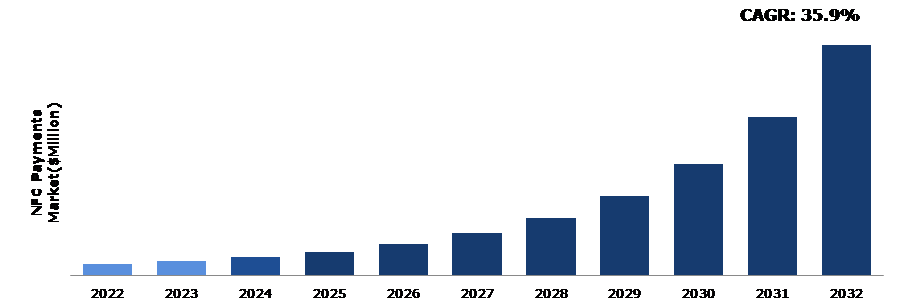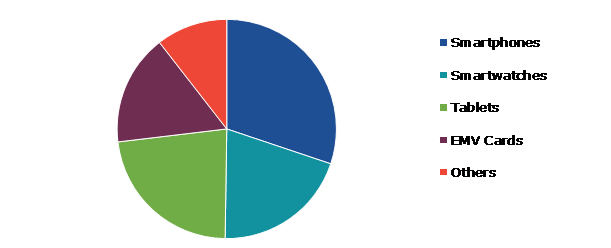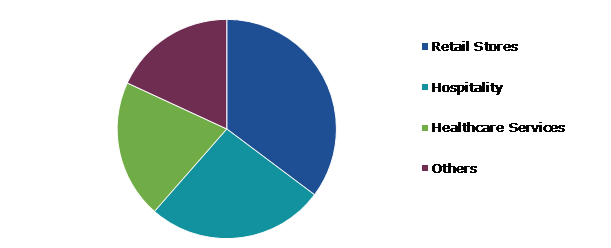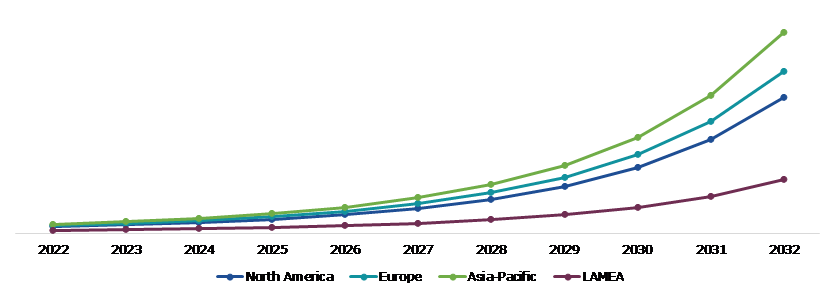NFC Payments Market Report
RA09173
NFC Payments Market by Device Type (Smartphones, Smartwatches, Tablets, EMV Cards, and Others), End User (Retail Stores, Hospitality, Healthcare Services, and Others), and Region (North America, Europe, Asia-Pacific, and LAMEA): Global Opportunity Analysis and Industry Forecast, 2023-2032
NFC Payments Overview
Near-field communication (NFC) is a technology that allows wireless-enabled devices in close proximity to communicate and share data. NFC offers a wide range of uses, including access control key fobs, ID verification, and wireless device pairing. NFC payments are made via an NFC-enabled reader. When activated by a POS system, this scanner sends out a signal that looks for an NFC-enabled payment device. When the reader identifies an NFC-enabled device's antenna, such as a phone or NFC-enabled credit card, the payment device communicates the payment information to the reader, and the payment is processed. NFC payments are contactless digital payment methods that allow phones, tablets, or credit cards to communicate with readers that support NFC. NFC technology enables businesses to take client payments swiftly and easily, without the need for personnel to handle the cards. NFC payments are a great way for a variety of enterprises, including stores, restaurants, and professional service providers to accept payments.
Global NFC Payments Market Analysis
Source: Research Dive Analysis
COVID-19 Impact on the Global NFC Payments Market
The COVID-19 pandemic has had a significant impact on the various industries including the financial industry. During the pandemic, lockdown regulations were imposed by governments of various countries, and as a result, banks and other financial institutions had to operate under certain regulations. These regulations have benefited the demand for contactless payments in the market. In addition, people began to avoid using cash to reduce the risk of infection due to the highly contagious nature of COVID-19. This shift in behavior has led to a substantial increase in the use of NFC payments. NFC payment methods offer a contactless option for transferring money, and as a result, people worldwide widely adopted this method for making payments.
The COVID-19 pandemic has accelerated the digitization of payments. For instance, according to a report published by the BIS Committee on Payments and Market Infrastructures (CPMI) in 2021, data from the RED book Statistics report indicates that consumers have transitioned from using physical cash to digital and contactless payment methods at an unprecedented rate.
Flexibility, Speed, and Convenience offered by NFC Payments Methods to Drive the Growth of the Market
The flexibility, speed, and convenience offered by NFC payment methods have emerged as significant drivers for the growth of this market. In recent years, there has been a profound shift in how people make payments, and NFC technology has played a pivotal role in this transformation. The speed of contactless transactions is remarkable, eliminating the need for physically inserting cards or entering PINs, thus reducing transaction times significantly. This level of efficiency benefits both retailers and consumers, especially in quick retail transactions. With the increasing prevalence of smartphones and rapid advancements in mobile payment technologies, NFC payments have become accessible to a broader spectrum of retailers. Leading payment apps like Apple Pay and Google Pay have integrated contactless capabilities, providing users with a familiar and user-friendly platform. The ease of use offered by mobile phones and dedicated applications has emerged as a driving force behind the widespread adoption of contactless payments among retailers and consumers, which is expected to drive the NFC payments market growth during the forecast years.
Security Concerns Related to NFC Payments to Restrain the Growth of the Market
The transition facilitated by the use of NFC payment methods does not require any form of PIN authorization during transactions. Consequently, there exists a sense of apprehension among people when utilizing NFC payments or contactless cards due to the absence of PIN verification. In the event of theft or fraudulent activity, contactless cards may be exploited for unauthorized transactions. In addition, hackers possess the capability to manipulate NFC tags embedded in smart devices, enabling the illicit transfer of users' private data to unauthorized devices. These factors are anticipated to restrain the NFC payments market growth in the upcoming years.
Increasing Cashless Economy Around the Globe to Create Growth Opportunities in the Market
The increasing prevalence of contactless payment technology is paving the way for the growth of a cashless economy around the globe. This unique advancement has revolutionized how people conduct transactions for goods and services, and its popularity continues to rise with the widespread adoption of mobile payments, contactless credit cards, and various payment systems. The ongoing reduction in the number of physical cash points, along with the accelerated shift towards online banking and modernized payment processes, signifies a movement towards a cashless society. This transition offers numerous advantages for both individuals and businesses. From an individual standpoint, it simplifies the process of making purchases, eliminating the need to carry physical cash and reducing the risk of financial loss due to theft. Moreover, it facilitates efficient payment tracking, aiding law enforcement agencies in identifying and mitigating illegal activities. For businesses, the surge in contactless payment technology streamlines payment acceptance, allowing retailers to effortlessly process card transactions without the need for expensive payment terminals or contactless machines. In addition, the expeditious nature of contactless payments, compared to cash or checks, enhances the overall transaction experience, eliminating the need for change in small purchases. As the world continues its transition towards a cashless economy, this trend is creating substantial growth opportunities within the NFC payments market, benefiting both consumers and businesses alike.
Global NFC Payments Market Share, by Device Type, 2022
Source: Research Dive Analysis
The smartphones sub-segment accounted for a dominant market share in 2022. As mobile and contactless payments continue to gain traction, smartphones have emerged as the primary drivers of this changing landscape. With the convenience of mobile payment apps and the proliferation of NFC-enabled smartphones, consumers are increasingly turning to their devices for quick, secure, and contactless transactions. This surge in smartphone usage for payments highlights the pivotal role these devices play in shaping the future of mobile and contactless payment methods, reaffirming their position as a key trend and growth driver within the market.
Global NFC Payments Market Share, by End User, 2022
Source: Research Dive Analysis
The retail stores sub-segment accounted for a dominant market share in 2022. Within the NFC payments market, retail stores have experienced a surge in innovation and an increase in competition. In response to the growing popularity of contactless payments, retailers are actively struggling to distinguish themselves by providing cutting-edge payment options to their customers. This dynamic environment often leads to increased investments in emerging technologies and the creation of novel, consumer-centric solutions. Retailers are keen on meeting the ever-evolving demands of consumers by offering convenient, secure, and efficient payment methods. Therefore, the NFC payments market continues to witness the transformation of retail stores into hubs of innovation, where the latest advancements in payment technology are embraced to enhance the overall shopping experience.
Global NFC Payments Market Size & Forecast, by Region, 2022-2032 ($Million)
Source: Research Dive Analysis
The North America NFC payments market generated the maximum revenue in 2022. In North America, the NFC payments industry has seen remarkable growth, and the evidence from the U.S. Federal Reserve's report is compelling. In 2018, the region witnessed approximately 700 million contactless card payments, accounting for a substantial $20 billion. The momentum continued into 2019, with 1.6 billion transactions totaling $50 billion. However, it was in 2020 that the market experienced a true game-changing moment. Contactless card payments increased rapidly by a staggering 172.3%, surging to 3.7 billion transactions, which amounted to an impressive $110 billion. This exponential growth was, in part, driven by consumers' increased concerns about shared touchpoints during the pandemic, prompting them to embrace contactless payments as a safer alternative.
Competitive Scenario in the Global NFC Payments Market
Investment and agreement are common strategies followed by major market players. For instance, in August 2023, J.P. Morgan Payments announced the availability of Tap to Pay on iPhone for its merchant clients in the U.S. Merchants can accept contactless payments using their iPhones without the requirement for a separate payments card reader or additional infrastructure.
Therefore, merchants and their consumers may engage and pay anywhere with a Wi-Fi or cellphone connectivity, resulting in a speedy and seamless checkout experience. The system enables merchants to accept payments wherever in-store or on the go.
Source: Research Dive Analysis
Some of the leading players in the NFC payments market Google Pay, Apple Pay, Mastercard Paypass, Visa Paywave, Samsung Pay, PayPal, Venmo, Square Wallet, Pomelo Pay, and WePay.
| Aspect
| Particulars
|
| Historical Market Estimations
| 2020-2021 |
| Base Year for Market Estimation
| 2022 |
| Forecast Timeline for Market Projection
| 2023-2032 |
| Geographical Scope
| North America, Europe, Asia-Pacific, and LAMEA |
| Segmentation By Device Type
|
|
| Segmentation By End User
|
|
| Key Companies Profiled
|
|
Q1. What is the size of the global NFC payments market?
A. The size of the global NFC payments market was over $25,768.50 million in 2022 and is projected to reach $507,078.30 million by 2032.
Q2. Which are the major companies in the NFC payments market?
A. Google Pay and Apple Pay are some of the key players in the global NFC payments market.
Q3. Which region, among others, possesses greater investment opportunities in the future?
A. Asia-Pacific possesses great investment opportunities for investors in the future.
Q4. What will be the growth rate of the Asia-Pacific NFC payments market?
A. The Asia-Pacific NFC payments market is anticipated to grow at 36.7% CAGR during the forecast period.
Q5. What are the strategies opted by the leading players in this market?
A. Agreement and investment are the two key strategies opted by the operating companies in this market.
Q6. Which companies are investing more on R&D practices?
A. Mastercard Paypass and Visa Paywave are the companies investing more on R&D activities for developing new products and technologies.
1. Research Methodology
1.1. Desk Research
1.2. Real time insights and validation
1.3. Forecast model
1.4. Assumptions and forecast parameters
1.5. Market size estimation
1.5.1. Top-down approach
1.5.2. Bottom-up approach
2. Report Scope
2.1. Market definition
2.2. Key objectives of the study
2.3. Report overview
2.4. Market segmentation
2.5. Overview of the impact of COVID-19 on global NFC payments market
3. Executive Summary
4. Market Overview
4.1. Introduction
4.2. Growth impact forces
4.2.1. Drivers
4.2.2. Restraints
4.2.3. Opportunities
4.3. Market value chain analysis
4.3.1. List of raw material suppliers
4.3.2. List of manufacturers
4.3.3. List of distributors
4.4. Innovation & sustainability matrices
4.4.1. Technology matrix
4.4.2. Regulatory matrix
4.5. Porter’s five forces analysis
4.5.1. Bargaining power of suppliers
4.5.2. Bargaining power of consumers
4.5.3. Threat of substitutes
4.5.4. Threat of new entrants
4.5.5. Competitive Rivalry intensity
4.6. PESTLE analysis
4.6.1. Political
4.6.2. Economical
4.6.3. Social
4.6.4. Technological
4.6.5. Environmental
4.7. Impact of COVID-19 on the NFC payments market
4.7.1. Pre-covid market scenario
4.7.2. Post-covid market scenario
5. NFC payments market Analysis, by Device Type
5.1. Overview
5.2. Smartphones
5.2.1. Definition, key trends, growth factors, and opportunities
5.2.2. Market size analysis, by region, 2023-2032
5.2.3. Market share analysis, by country, 2023-2032
5.3. Smartwatches
5.3.1. Definition, key trends, growth factors, and opportunities
5.3.2. Market size analysis, by region, 2023-2032
5.3.3. Market share analysis, by country, 2023-2032
5.4. Tablets
5.4.1. Definition, key trends, growth factors, and opportunities
5.4.2. Market size analysis, by region, 2023-2032
5.4.3. Market share analysis, by country, 2023-2032
5.5. EMV Cards
5.5.1. Definition, key trends, growth factors, and opportunities
5.5.2. Market size analysis, by region, 2023-2032
5.5.3. Market share analysis, by country, 2023-2032
5.6. Others
5.6.1. Definition, key trends, growth factors, and opportunities
5.6.2. Market size analysis, by region, 2023-2032
5.6.3. Market share analysis, by country, 2023-2032
5.7. Research Dive Exclusive Insights
5.7.1. Market attractiveness
5.7.2. Competition heatmap
6. NFC payments market Analysis, by End User
6.1. Retail Stores
6.1.1. Definition, key trends, growth factors, and opportunities
6.1.2. Market size analysis, by region, 2023-2032
6.1.3. Market share analysis, by country, 2023-2032
6.2. Hospitality
6.2.1. Definition, key trends, growth factors, and opportunities
6.2.2. Market size analysis, by region, 2023-2032
6.2.3. Market share analysis, by country, 2023-2032
6.3. Healthcare Services
6.3.1. Definition, key trends, growth factors, and opportunities
6.3.2. Market size analysis, by region, 2023-2032
6.3.3. Market share analysis, by country, 2023-2032
6.4. Others
6.4.1. Definition, key trends, growth factors, and opportunities
6.4.2. Market size analysis, by region, 2023-2032
6.4.3. Market share analysis, by country, 2023-2032
6.5. Research Dive Exclusive Insights
6.5.1. Market attractiveness
6.5.2. Competition heatmap
7. NFC payments market, by Region
7.1. North America
7.1.1. U.S.
7.1.1.1. Market size analysis, by Device Type, 2023-2032
7.1.1.2. Market size analysis, by End User, 2023-2032
7.1.2. Canada
7.1.2.1. Market size analysis, by Device Type, 2023-2032
7.1.2.2. Market size analysis, by End User, 2023-2032
7.1.3. Mexico
7.1.3.1. Market size analysis, by Device Type, 2023-2032
7.1.3.2. Market size analysis, by End User, 2023-2032
7.1.4. Research Dive Exclusive Insights
7.1.4.1. Market attractiveness
7.1.4.2. Competition heatmap
7.2. Europe
7.2.1. Germany
7.2.1.1. Market size analysis, by Device Type, 2023-2032
7.2.1.2. Market size analysis, by End User, 2023-2032
7.2.2. UK
7.2.2.1. Market size analysis, by Device Type, 2023-2032
7.2.2.2. Market size analysis, by End User, 2023-2032
7.2.3. France
7.2.3.1. Market size analysis, by Device Type, 2023-2032
7.2.3.2. Market size analysis, by End User, 2023-2032
7.2.4. Spain
7.2.4.1. Market size analysis, by Device Type, 2023-2032
7.2.4.2. Market size analysis, by End User, 2023-2032
7.2.5. Italy
7.2.5.1. Market size analysis, by Device Type, 2023-2032
7.2.5.2. Market size analysis, by End User, 2023-2032
7.2.6. Rest of Europe
7.2.6.1. Market size analysis, by Device Type, 2023-2032
7.2.6.2. Market size analysis, by End User, 2023-2032
7.2.7. Research Dive Exclusive Insights
7.2.7.1. Market attractiveness
7.2.7.2. Competition heatmap
7.3. Asia-Pacific
7.3.1. China
7.3.1.1. Market size analysis, by Device Type, 2023-2032
7.3.1.2. Market size analysis, by End User, 2023-2032
7.3.2. Japan
7.3.2.1. Market size analysis, by Device Type, 2023-2032
7.3.2.2. Market size analysis, by End User, 2023-2032
7.3.3. India
7.3.3.1. Market size analysis, by Device Type, 2023-2032
7.3.3.2. Market size analysis, by End User, 2023-2032
7.3.4. Australia
7.3.4.1. Market size analysis, by Device Type, 2023-2032
7.3.4.2. Market size analysis, by End User, 2023-2032
7.3.5. South Korea
7.3.5.1. Market size analysis, by Device Type, 2023-2032
7.3.5.2. Market size analysis, by End User, 2023-2032
7.3.6. Rest of Asia-Pacific
7.3.6.1. Market size analysis, by Device Type, 2023-2032
7.3.6.2. Market size analysis, by End User, 2023-2032
7.3.7. Research Dive Exclusive Insights
7.3.7.1. Market attractiveness
7.3.7.2. Competition heatmap
7.4. LAMEA
7.4.1. Brazil
7.4.1.1. Market size analysis, by Device Type, 2023-2032
7.4.1.2. Market size analysis, by End User, 2023-2032
7.4.2. Saudi Arabia
7.4.2.1. Market size analysis, by Device Type, 2023-2032
7.4.2.2. Market size analysis, by End User, 2023-2032
7.4.3. UAE
7.4.3.1. Market size analysis, by Device Type, 2023-2032
7.4.3.2. Market size analysis, by End User, 2023-2032
7.4.4. South Africa
7.4.4.1. Market size analysis, by Device Type, 2023-2032
7.4.4.2. Market size analysis, by End User, 2023-2032
7.4.5. Rest of LAMEA
7.4.5.1. Market size analysis, by Device Type, 2023-2032
7.4.5.2. Market size analysis, by End User, 2023-2032
7.4.6. Research Dive Exclusive Insights
7.4.6.1. Market attractiveness
7.4.6.2. Competition heatmap
8. Competitive Landscape
8.1. Top winning strategies, 2022
8.1.1. By strategy
8.1.2. By year
8.2. Strategic overview
8.3. Market share analysis, 2021
9. Company Profiles
9.1. Google Pay
9.1.1. Overview
9.1.2. Business segments
9.1.3. Product portfolio
9.1.4. Financial performance
9.1.5. Recent developments
9.1.6. SWOT analysis
9.2. Apple Pay
9.2.1. Overview
9.2.2. Business segments
9.2.3. Product portfolio
9.2.4. Financial performance
9.2.5. Recent developments
9.2.6. SWOT analysis
9.3. Mastercard Paypass
9.3.1. Overview
9.3.2. Business segments
9.3.3. Product portfolio
9.3.4. Financial performance
9.3.5. Recent developments
9.3.6. SWOT analysis
9.4. Visa Paywave
9.4.1. Overview
9.4.2. Business segments
9.4.3. Product portfolio
9.4.4. Financial performance
9.4.5. Recent developments
9.4.6. SWOT analysis
9.5. Samsung Pay
9.5.1. Overview
9.5.2. Business segments
9.5.3. Product portfolio
9.5.4. Financial performance
9.5.5. Recent developments
9.5.6. SWOT analysis
9.6. PayPal
9.6.1. Overview
9.6.2. Business segments
9.6.3. Product portfolio
9.6.4. Financial performance
9.6.5. Recent developments
9.6.6. SWOT analysis
9.7. Venmo
9.7.1. Overview
9.7.2. Business segments
9.7.3. Product portfolio
9.7.4. Financial performance
9.7.5. Recent developments
9.7.6. SWOT analysis
9.8. Square Wallet
9.8.1. Overview
9.8.2. Business segments
9.8.3. Product portfolio
9.8.4. Financial performance
9.8.5. Recent developments
9.8.6. SWOT analysis
9.9. Pomelo Pay
9.9.1. Overview
9.9.2. Business segments
9.9.3. Product portfolio
9.9.4. Financial performance
9.9.5. Recent developments
9.9.6. SWOT analysis
9.10. WePay
9.10.1. Overview
9.10.2. Business segments
9.10.3. Product portfolio
9.10.4. Financial performance
9.10.5. Recent developments
9.10.6. SWOT analysis
Personalize this research
- Triangulate with your own data
- Request your format and definition
- Get a deeper dive on a specific application, geography, customer or competitor
- + 1-888-961-4454 Toll - Free
- support@researchdive.com






